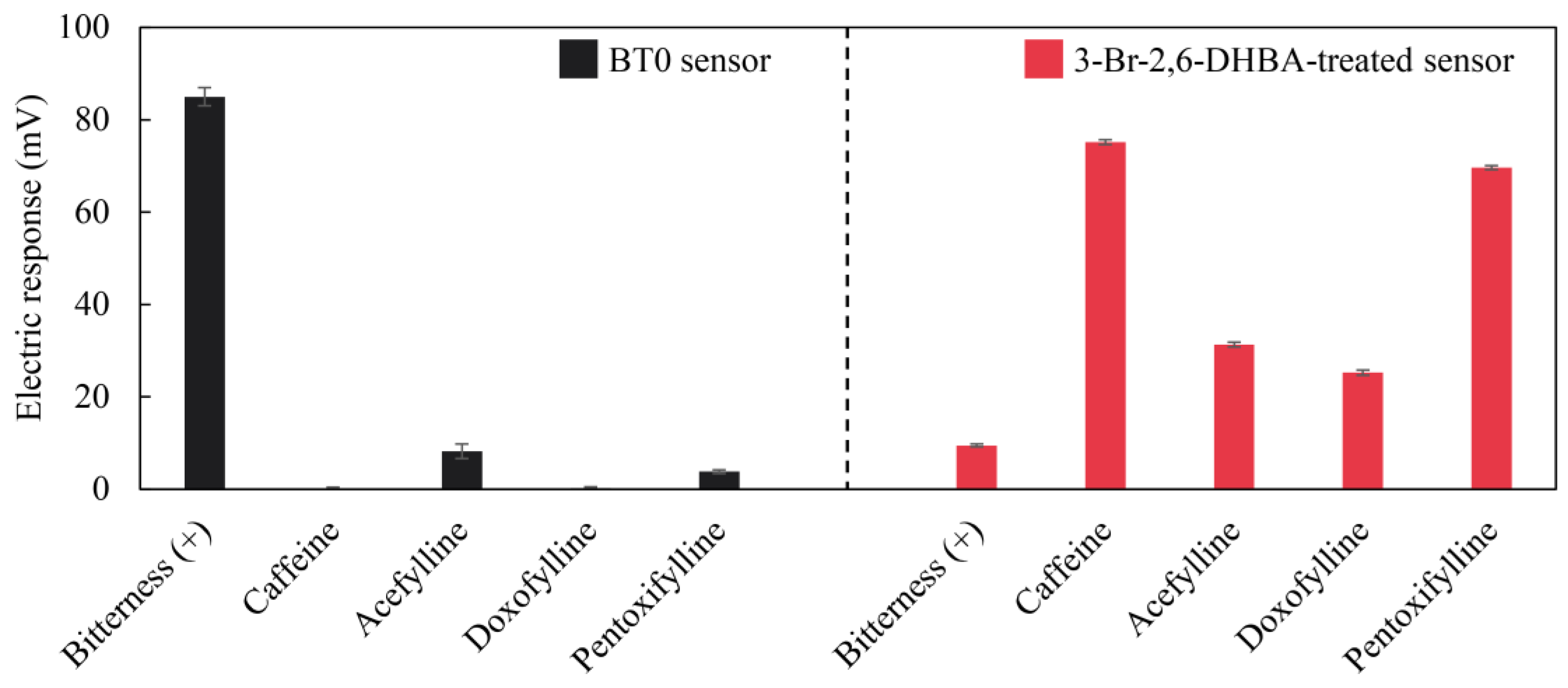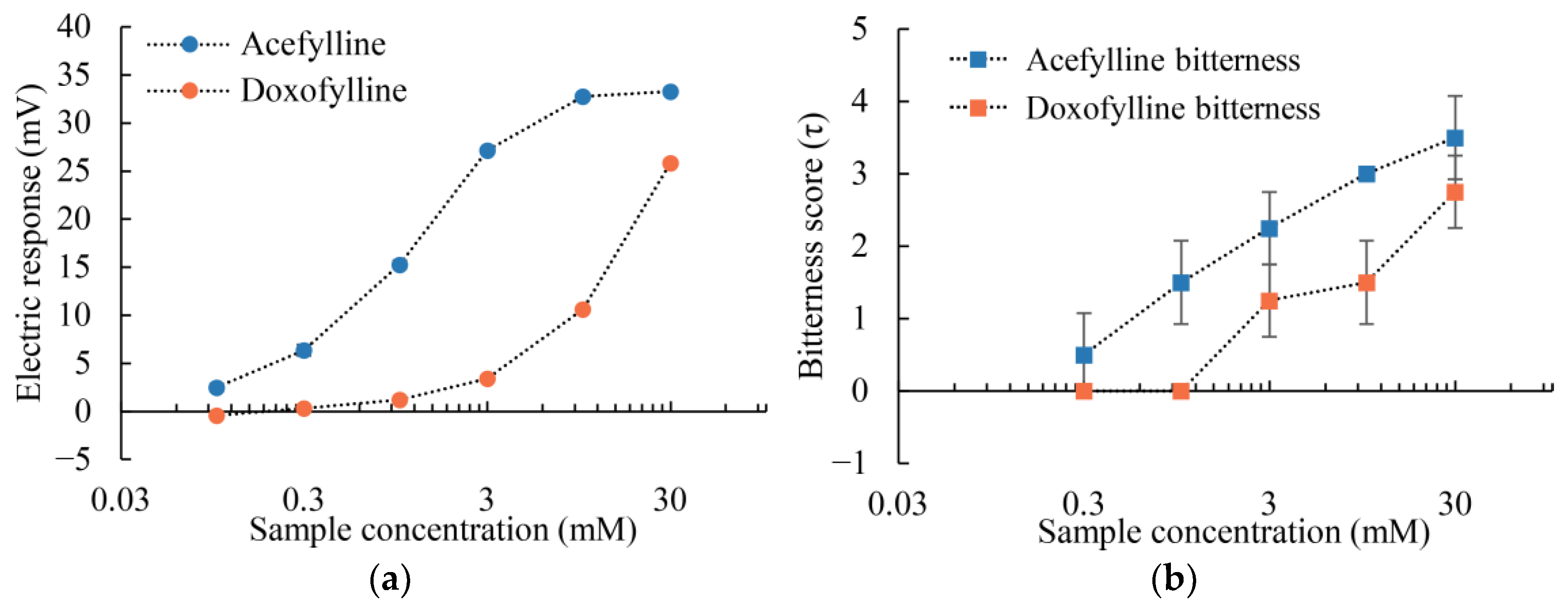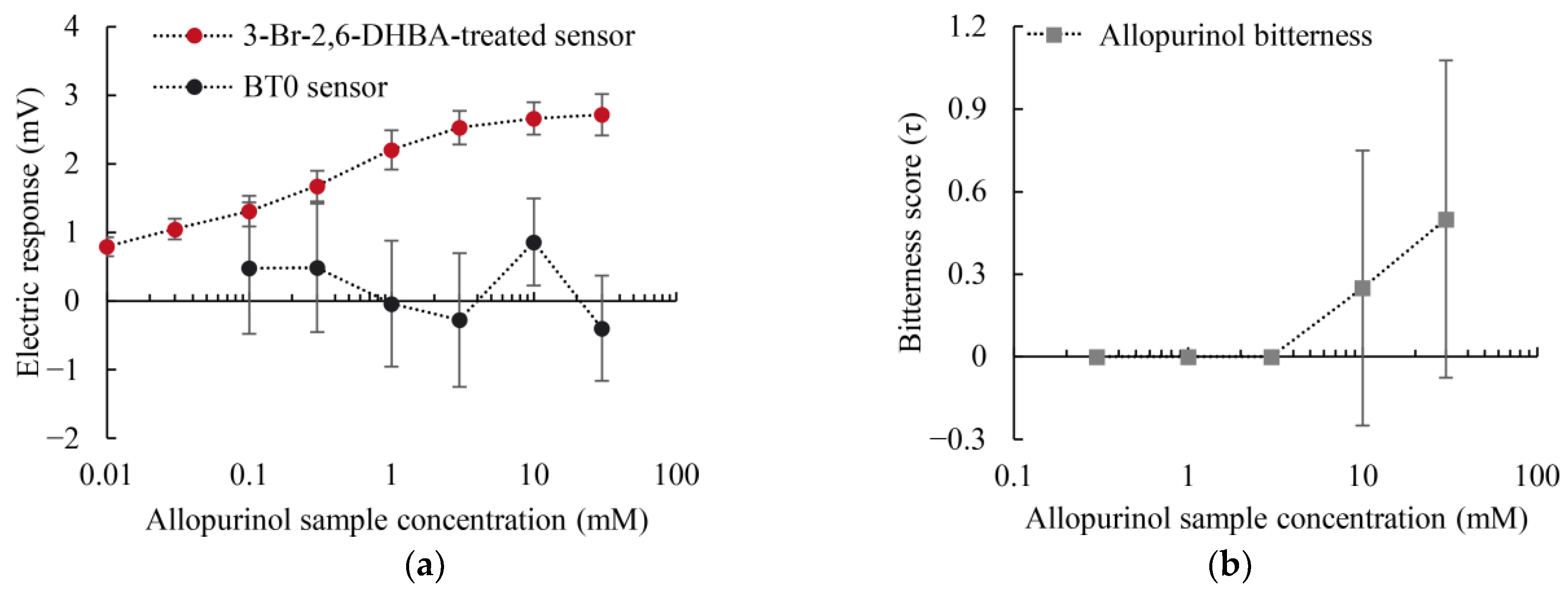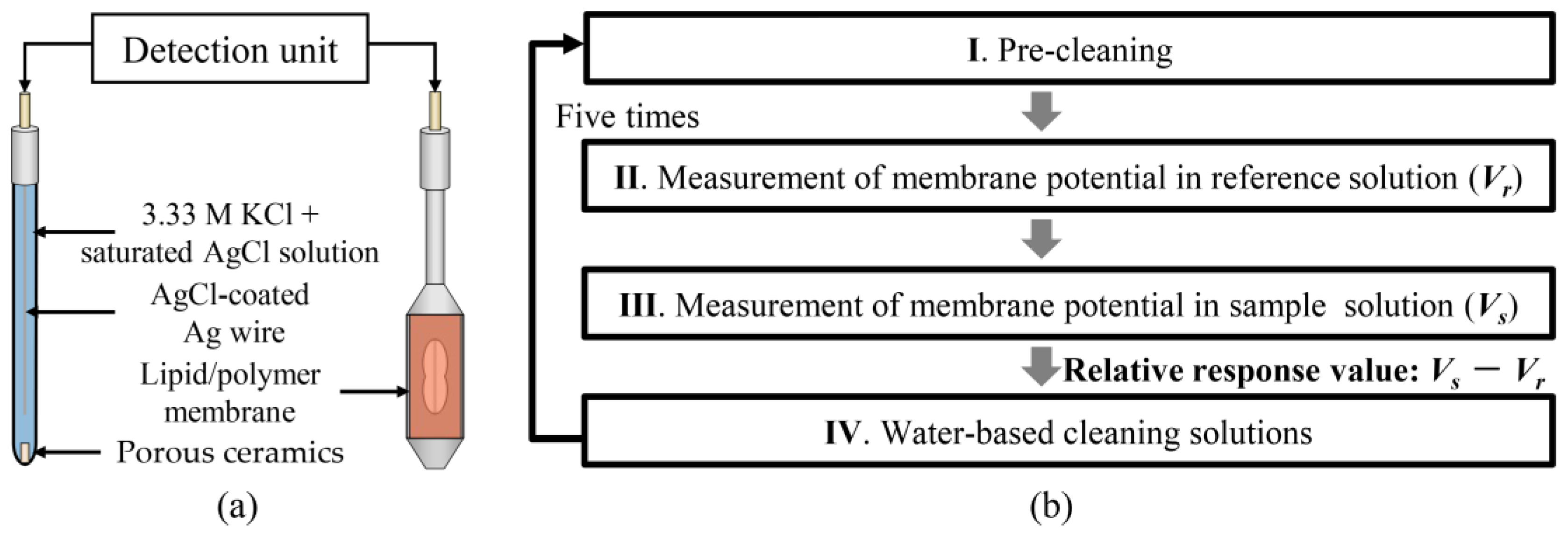Assessment of Bitterness in Non-Charged Pharmaceuticals with a Taste Sensor: A Study on Substances with Xanthine Scaffold and Allopurinol
Abstract
:1. Introduction
2. Results and Discussion
2.1. Confirmation of Sensitivity for BT0 Sensor and 3-Br-2,6-DHBA-Treated Sensor to Non-Charged Bitter Substances
2.2. Taste Sensor Measurement and Sensory Tests of Acefylline and Doxofylline
2.2.1. Concentration-Dependent Measurements Using 3-Br-2,6-DHBA-Treated Sensor and Sensory Tests
2.2.2. Comparison with Taste Sensor Results and Sensory Test Outcomes
2.3. Taste Sensor Measurement and Sensory Test for Allopurinol
2.4. Assessment of the Bitterness for Pentoxifylline
2.4.1. Concentration-Dependent Measurements for Pentoxifylline Using 3-Br-2,6-DHBA-Treated Sensor
2.4.2. Assessment of the Bitterness for Pentoxifylline
2.5. The Effectiveness of Xanthine Scaffold in Detection with 3-Br-2,6-DHBA-Treated Taste Sensors
3. Materials and Methods
3.1. Reagents
3.2. Sensor Preparation: Lipid/Polymer Membrane and Surface Modification
3.3. Taste Sensor Measurement
3.3.1. Measurement Procedure of Taste Sensor
3.3.2. Selectivity Measurement for Bitter Substances Using BT0 Sensor and 3-Br-2,6-DHBA-Treated Sensor
3.3.3. Measurement for Acefylline, Doxofylline, and Pentoxifylline Using 3-Br-2,6-DHBA-Treated Sensor
3.3.4. Measurement for Allopurinol Using BT0 Sensor and 3-Br-2,6-DHBA-Treated Sensor
3.4. Sensory Tests for Acefylline, Doxofylline, and Allopurinol
4. Conclusions
Author Contributions
Funding
Institutional Review Board Statement
Informed Consent Statement
Data Availability Statement
Conflicts of Interest
References
- Baguley, D.; Lim, E.; Bevan, A.; Pallet, A.; Faust, S.N. Prescribing for children—Taste and palatability affect adherence to antibiotics: A review. Arch. Dis. Child. 2012, 97, 293–297. [Google Scholar] [CrossRef] [PubMed]
- Matsui, D. Current issues in pediatric medication adherence. Pediatr. Drugs 2007, 9, 283–288. [Google Scholar] [CrossRef] [PubMed]
- Mennella, J.A.; Beauchamp, G.K. Optimizing oral medications for children. Clin. Ther. 2008, 30, 2120–2132. [Google Scholar] [CrossRef] [PubMed]
- Kendrick, J.G.; Ma, K.; DeZorzi, P.; Hamilton, D. Vomiting of oral medications by pediatric patients: Survey of medication redosing practices. Can. J. Hosp. Pharm. 2012, 65, 196–201. [Google Scholar] [CrossRef] [PubMed]
- Sohi, H.; Sultana, Y.; Khar, R.K. Taste masking technologies in oral pharmaceuticals: Recent developments and approaches. Drug Dev. Ind. Pharm. 2004, 30, 429–448. [Google Scholar] [CrossRef] [PubMed]
- Mennella, J.A.; Spector, A.C.; Reed, D.R.; Coldwell, S.E. The bad taste of medicines: Overview of basic research on bitter taste. Clin. Ther. 2013, 35, 1225–1246. [Google Scholar] [CrossRef] [PubMed]
- Anand, V.; Kataria, M.; Kukkar, V.; Saharan, V.; Choudhury, P.K. The latest trends in the taste assessment of pharmaceuticals. Drug Discov Today. 2007, 12, 257–265. [Google Scholar] [CrossRef] [PubMed]
- Chen, Z.; Wu, J.; Zhao, Y.; Xu, F.; Hu, Y. Recent advances in bitterness evaluation methods. Anal. Methods 2012, 4, 599. [Google Scholar] [CrossRef]
- Doty, R.L.; Shah, M.; Bromley, S.M. Drug-induced taste disorders. Drug Saf. 2008, 31, 199–215. [Google Scholar] [CrossRef]
- Cram, A.; Breitkreutz, J.; Desset-Brèthes, S.; Nunn, T.; Tuleu, C. Challenges of developing palatable oral paediatric formulations. Int. J. Pharm. 2009, 365, 1–3. [Google Scholar] [CrossRef]
- Schiffman, S.S. Critical illness and changes in sensory perception. Proc. Nutr. Soc. 2007, 66, 331–345. [Google Scholar] [CrossRef] [PubMed]
- Liu, R.X.; Gao, X.J.; Wang, J.M.; Dai, L.P.; Kang, B.Y.; Zhang, L.; Shi, J.H.; Gui, X.J.; Liu, P.; Li, X.L. Traditional human taste panel and taste sensors methods for bitter taste masking research on combined bitterness suppressants of berberine hydrochloride. Sens. Mater. 2017, 29, 105–116. [Google Scholar] [CrossRef]
- Cui, S.; Wang, J.; Geng, L.; Wei, Z.; Tian, X. Determination of ginseng with different ages using a taste-sensing system. Sens. Mater. 2013, 25, 241–255. [Google Scholar] [CrossRef]
- Woertz, K.; Tissen, C.; Kleinebudde, P.; Breitkreutz, J. A comparative study on two electronic tongues for pharmaceutical formulation development Katharina. J. Pharm. Biomed. Anal. 2011, 55, 272–281. [Google Scholar] [CrossRef] [PubMed]
- Cetó, X.; Pérez, S.; Prieto-Simón, B. Fundamentals and application of voltammetric electronic tongues in quantitative analysis. TrAC Trends Anal. Chem. 2022, 157, 116765. [Google Scholar] [CrossRef]
- Woertz, K.; Tissen, C.; Kleinebudde, P.; Breitkreutz, J. Taste sensing systems (electronic tongues) for pharmaceutical applications. Int. J. Pharm. 2011, 417, 256–271. [Google Scholar] [CrossRef]
- Li, L.; Naini, V.; Ahmed, S.U. Utilization of a modified special-cubic design and an electronic tongue for bitterness masking formulation optimization. J. Pharm. Sci. 2007, 96, 2723–2734. [Google Scholar] [CrossRef]
- Khalilian, A.; Khan, M.R.R.; Kang, S.-W. Highly sensitive and wide-dynamic-range side-polished fiber-optic taste sensor. Sens. Actuators B Chem. 2017, 249, 700–707. [Google Scholar] [CrossRef]
- Chung, S.; Park, T.S.; Park, S.H.; Kim, J.Y.; Park, S.; Son, D.; Bae, Y.M.; Cho, S.I. Colorimetric sensor array for white wine tasting. Sensors 2015, 15, 18197–18208. [Google Scholar] [CrossRef]
- Kozitsina, A.; Svalova, T.; Malysheva, N.; Okhokhonin, A.; Vidrevich, M.; Brainina, K. Sensors based on bio and biomimetic receptors in medical diagnostic, environment, and food analysis. Biosensors 2018, 8, 35. [Google Scholar] [CrossRef]
- Ciosek, P.; Wróblewski, W. Sensor arrays for liquid sensing—Electronic tongue systems. Analyst 2007, 132, 963–978. [Google Scholar] [CrossRef] [PubMed]
- Riul, A.; Dantas, C.A.R.; Miyazaki, C.M.; Oliveira, O.N. Recent advances in electronic tongues. Analyst 2010, 135, 2481–2495. [Google Scholar] [CrossRef] [PubMed]
- Toko, K. Research and development of taste sensors as a novel analytical tool. Proc. Japan Acad. Ser. B 2023, 99, 173–189. [Google Scholar] [CrossRef] [PubMed]
- Haraguchi, T.; Uchida, T.; Yoshida, M.; Kojima, H.; Habara, M.; Ikezaki, H. The utility of the artificial taste sensor in evaluating the bitterness of drugs: Correlation with responses of human TASTE2 receptors (hTAS2Rs). Chem. Pharm. Bull. 2018, 66, 71–77. [Google Scholar] [CrossRef] [PubMed]
- Zhang, H.; Zou, G.; Liu, W.; Zhou, Z. Beer taste detection based on electronic tongue. Sens. Mater. 2020, 32, 2949. [Google Scholar] [CrossRef]
- Hayashi, N.; Chen, R.; Ikezaki, H.; Yamaguchi, S.; Maruyama, D.; Yamaguchi, Y.; Ujihara, T.; Kohata, K. Techniques for universal evaluation of astringency of green tea infusion by the use of a taste sensor system. Biosci. Biotechnol. Biochem. 2006, 70, 626–631. [Google Scholar] [CrossRef] [PubMed]
- Kojima, H.; Kurihara, T.; Yoshida, M.; Haraguchi, T.; Nishikawa, H.; Ikegami, S.; Okuno, T.; Yamashita, T.; Nishikawa, J.; Tsujino, H.; et al. A new bitterness evaluation index obtained using the taste sensor for 48 active pharmaceutical ingredients of pediatric medicines. Chem. Pharm. Bull. 2021, 69, 537–547. [Google Scholar] [CrossRef] [PubMed]
- Yoshida, M.; Haraguchi, T.; Uchida, T. Bitterness evaluation of acidic pharmaceutical substances (NSAIDs) using a taste sensor. Chem. Pharm. Bull. 2014, 62, 1252–1258. [Google Scholar] [CrossRef] [PubMed]
- Ito, M.; Yoshida, M.; Kobayashi, Y.; Hiraoka, M.; Ikezaki, H.; Uchida, T. Bitterness evaluation of H1-Receptor antagonists using a taste sensor. Sens. Mater. 2011, 23, 483–492. [Google Scholar]
- Yoshimatsu, J.; Toko, K.; Tahara, Y.; Ishida, M.; Habara, M.; Ikezaki, H.; Kojima, H.; Ikegami, S.; Yoshida, M.; Uchida, T. Development of taste sensor to detect non-charged bitter substances. Sensors 2020, 20, 3455. [Google Scholar] [CrossRef]
- Ishida, M.; Ide, H.; Arima, K.; Zhao, Z.; Matsui, T.; Toko, K. Identification of the principle of taste sensors to detect non-charged bitter substances by 1H-NMR measurement. Sensors 2022, 22, 2592. [Google Scholar] [CrossRef] [PubMed]
- Zhang, F.; Klebansky, B.; Fine, R.M.; Xu, H.; Pronin, A.; Liu, H.; Tachdjian, C.; Li, X. Molecular mechanism for the umami taste synergism. Proc. Natl. Acad. Sci. USA 2008, 105, 20930–20934. [Google Scholar] [CrossRef] [PubMed]
- Chen, K.Y.M.; Keri, D.; Barth, P. Computational design of G Protein-Coupled Receptor allosteric signal transductions. Nat. Chem. Biol. 2020, 16, 77–86. [Google Scholar] [CrossRef] [PubMed]
- Liu, J.; Nussinov, R. Allostery: An overview of its history, concepts, methods, and applications. PLoS Comput. Biol. 2016, 12, e1004966. [Google Scholar] [CrossRef] [PubMed]
- Lindsley, J.E.; Rutter, J. Whence cometh the allosterome? Proc. Natl. Acad. Sci. USA 2006, 103, 10533–10535. [Google Scholar] [CrossRef] [PubMed]
- Monod, J.; Wyman, J.; Changeux, J.P. On the nature of allosteric transitions: A plausible model. J. Mol. Biol. 1965, 12, 88–118. [Google Scholar] [CrossRef] [PubMed]
- Swain, J.F.; Gierasch, L.M. The changing landscape of protein allostery. Curr. Opin. Struct. Biol. 2006, 16, 102–108. [Google Scholar] [CrossRef] [PubMed]
- Gunasekaran, K.; Ma, B.; Nussinov, R. Is allostery an intrinsic property of all dynamic proteins? Proteins Struct. Funct. Genet. 2004, 57, 433–443. [Google Scholar] [CrossRef] [PubMed]
- Xu, H.; Zhao, Z.; Kimura, S.; Onodera, T.; Toko, K. Molecular structure underlying the allosteric mechanism of caffeine detection in taste sensor. Chemosensors 2023, 11, 97. [Google Scholar] [CrossRef]
- Zhao, Z.; Song, F.; Kimura, S.; Onodera, T.; Uchida, T.; Toko, K. Taste sensor for detecting non-charged bitter substances: Xanthine derivatives of pharmaceutical applications. Microchem. J. 2024, 200, 110248. [Google Scholar] [CrossRef]
- Ogawa, K.; Takagi, K.; Satake, T. Mechanism of xanthine-induced relaxation of guinea-pig isolated trachealis muscle. Br. J. Pharmacol. 1989, 97, 542–546. [Google Scholar] [CrossRef] [PubMed]
- Schmidt, D.T.; Watson, N.; Dent, G.; Rühlmann, E.; Branscheid, D.; Magnussen, H.; Rabe, K.F. The effect of selective and non-selective phosphodiesterase inhibitors on allergen- and leukotriene C 4-induced contractions in passively sensitized human airways. Br. J. Pharmacol. 2000, 131, 1607–1618. [Google Scholar] [CrossRef]
- Dunwiddie, T.V.; Hoffer, B.J.; Fredholm, B.B. Alkylxanthines elevate hippocampal excitability. Naunyn. Schmiedebergs. Arch. Pharmacol. 1981, 316, 326–330. [Google Scholar] [CrossRef]
- Kaminski, J.J.; Solomon, D.M.; Conn, D.J.; Wong, S.C.; Chiu, P.J.S.; Massa, T.; Watnick, A.S.; Siegel, M.I. Antiinflammatory activity of a series of substituted 2,3-dihydro-6-hydroxypyrimido[2,l-f]purine-4,8(1H,9H)-diones. J. Med. Chem. 1989, 32, 1118–1127. [Google Scholar] [CrossRef]
- Famulok, M.; Hayallah, A.M. Synthesis of new 1,3,8-trisubstituted purine-2,6-diones and 1,3,6-trisubstituted thiazolo 2,3-f]purine-2,4-diones. Heterocycles 2007, 74, 369. [Google Scholar] [CrossRef]
- Hayallah, A.M.; Momekov, G.; Famulok, M. Antitumor activity of some new 1,3,8-trisubstituted purine-2,6-diones and 1,3,6-trisubstituted thiazolo [2,3-f]purine-2,4-diones. Bull. Pharm. Sci. 2008, 31, 391–399. [Google Scholar] [CrossRef]
- Heizmann, G.; Eberle, A.N. Xanthines as a scaffold for molecular diversity. Mol. Divers. 1997, 2, 171–174. [Google Scholar] [CrossRef] [PubMed]
- Basu, S.; Barawkar, D.A.; Ramdas, V.; Patel, M.; Waman, Y.; Panmand, A.; Kumar, S.; Thorat, S.; Naykodi, M.; Goswami, A.; et al. Design and synthesis of novel xanthine derivatives as potent and selective A 2B adenosine receptor antagonists for the treatment of chronic inflammatory airway diseases. Eur. J. Med. Chem. 2017, 134, 218–229. [Google Scholar] [CrossRef]
- Shahzadi, I.; Zahoor, A.F.; Parveen, B.; Rasul, A.; Raza, Z.; Ahmad, S.; Irfan, A.; El-Hiti, G.A. Acefylline derivatives as a new class of anticancer agents: Synthesis, molecular docking, and anticancer, hemolytic, and thrombolytic activities of acefylline-triazole hybrids. J. Chem. 2022, 2022, 3502872. [Google Scholar] [CrossRef]
- Page, C.P. Doxofylline: A “novofylline”. Pulm. Pharmacol. Ther. 2010, 23, 231–234. [Google Scholar] [CrossRef]
- Harris, E.; Schulzke, S.M.; Patole, S.K. Pentoxifylline in preterm neonates. Pediatr. Drugs 2010, 12, 301–311. [Google Scholar] [CrossRef] [PubMed]
- Siu, Y.-P.; Leung, K.-T.; Tong, M.K.-H.; Kwan, T.-H. Use of allopurinol in slowing the progression of renal disease through its ability to lower serum uric acid level. Am. J. Kidney Dis. 2006, 47, 51–59. [Google Scholar] [CrossRef] [PubMed]
- Wei, Z.B.; Wang, J.; Cui, S.Q.; Wang, Y. Determination of the flavours and marked ages of rice wines using a taste sensing system combined with the Weber-Fechner law and chemometric methods. Anal. Methods 2016, 8, 6361–6371. [Google Scholar] [CrossRef]
- Dehaene, S. The neural basis of the Weber-Fechner law: A logarithmic mental number line. Trends Cogn. Sci. 2003, 7, 145–147. [Google Scholar] [CrossRef] [PubMed]
- Shahzadi, I.; Zahoor, A.F.; Tüzün, B.; Mansha, A.; Anjum, M.N.; Rasul, A.; Irfan, A.; Kotwica-Mojzych, K.; Mojzych, M. Repositioning of acefylline as anti-cancer drug: Synthesis, anticancer and computational studies of azomethines derived from acefylline tethered 4-amino-3- mercapto-1,2,4-triazole. PLoS ONE 2022, 17, e0278027. [Google Scholar] [CrossRef] [PubMed]
- Matera, M.G.; Page, C.; Cazzola, M. Doxofylline is not just another theophylline! Int. J. Chron. Obstruct. Pulmon. Dis. 2017, 12, 3487–3493. [Google Scholar] [CrossRef] [PubMed]
- Latosińska, J.N.; Latosińska, M.; Seliger, J.; Žagar, V.; Kazimierczuk, Z. An insight into pototropism and supramolecular motifs in solid-state structures of allopurinol, hypoxanthine, xanthine, and uric acid. A1H–14N NQDR spectroscopy, hybrid DFT/QTAIM, and hirshfeld surface-based study. J. Phys. Chem. B 2014, 118, 10837–10853. [Google Scholar] [CrossRef] [PubMed]
- Worthington, H.V.; Clarkson, J.E.; Bryan, G.; Furness, S.; Glenny, A.-M.; Littlewood, A.; McCabe, M.G.; Meyer, S.; Khalid, T.; Riley, P. Interventions for preventing oral mucositis for patients with cancer receiving treatment. Cochrane Database Syst. Rev. 2011, 2021, 22. [Google Scholar] [CrossRef]
- Murata, Y.; Kofuji, K.; Nishida, N.; Kamaguchi, R. Development of film dosage form containing allopurinol for prevention and treatment of oral mucositis. ISRN Pharm. 2012, 2012, 764510. [Google Scholar] [CrossRef]
- Panahi, Y.; Ala, S.; Saeedi, M.; Okhovatian, A.; Bazzaz, N.; Naghizadeh, M.M. Allopurinol mouth rinse for prophylaxis of fluorouracil-induced mucositis. Eur. J. Cancer Care 2010, 19, 308–312. [Google Scholar] [CrossRef]
- Furukawa, S.; Matsubara, T.; Ino, T.; Yabuta, K.; Umezawa, Y.; Motohashi, T. Pentoxifylline and intravenous gamma globulin combination therapy for acute Kawasaki disease. Eur. J. Pediatr. 1994, 153, 663–667. [Google Scholar] [CrossRef] [PubMed]
- Best, B.M.; Burns, J.C.; DeVincenzo, J.; Phelps, S.J.; Blumer, J.L.; Wilson, J.T.; Capparelli, E.V.; Connor, J.D. Pharmacokinetic and tolerability assessment of a pediatric oral formulation of pentoxifylline in Kawasaki disease. Curr. Ther. Res. 2003, 64, 96–115. [Google Scholar] [CrossRef] [PubMed]
- McCarty, M.F.; O’Keefe, J.H.; DiNicolantonio, J.J. Pentoxifylline for vascular health: A brief review of the literature. Open Hear. 2016, 3, e000365. [Google Scholar] [CrossRef] [PubMed]
- Beermann, B.; Ings, R.; Månsby, J.; Chamberlain, J.; McDonald, A. Kinetics of intravenous and oral pentoxifylline in healthy subjects. Clin. Pharmacol. Ther. 1985, 37, 25–28. [Google Scholar] [CrossRef]
- Buhrer, T.; Gehrig, P.; Simon, W. Neutral-carrier-based ion-selective microelectrodes design and application. Anal. Sci. 1988, 4, 547–557. [Google Scholar] [CrossRef]
- Morf, W.E. The Principles of Ion-Selective Electrodes and of Membrane Transport, 1st ed.; Elsevier Science: Budapest, Hungary, 1981; Volume 1, ISBN 9780444597557. [Google Scholar]
- Ito, M.; Wada, K.; Yoshida, M.; Hazekawa, M.; Abe, K.; Chen, R.; Habara, M.; Ikezaki, H.; Uchida, T. Quantitative evaluation of bitterness of H1-Receptor antagonists and masking effect of acesulfame potassium, an artificial sweetener, using a taste Sensor. Sens. Mater. 2013, 25, 17. [Google Scholar] [CrossRef]
- Uchida, T.; Tanigake, A.; Miyanaga, Y.; Matsuyama, K.; Kunitomo, M.; Kobayashi, Y.; Ikezaki, H.; Taniguchi, A. Evaluation of the bitterness of antibiotics using a taste sensor. J. Pharm. Pharmacol. 2010, 55, 1479–1485. [Google Scholar] [CrossRef]









| Concentration (mM) | Repeatability (Intra-Day) RSD [%] | |
|---|---|---|
| Acefylline | Doxofylline | |
| 0.3 | 9.15 | 35.82 |
| 1 | 2.87 | 16.18 |
| 3 | 0.61 | 6.02 |
| 10 | 0.81 | 1.92 |
| 30 | 0.81 | 0.78 |
| Sample | Composition | Concentration |
|---|---|---|
| Bitterness (+) | quinine hydrochloride | 0.1 mM |
| Non-charged bitter substances | caffeine | 100 mM |
| acefylline | 30 mM | |
| doxofylline | 30 mM | |
| pentoxifylline | 100 mM |
Disclaimer/Publisher’s Note: The statements, opinions and data contained in all publications are solely those of the individual author(s) and contributor(s) and not of MDPI and/or the editor(s). MDPI and/or the editor(s) disclaim responsibility for any injury to people or property resulting from any ideas, methods, instructions or products referred to in the content. |
© 2024 by the authors. Licensee MDPI, Basel, Switzerland. This article is an open access article distributed under the terms and conditions of the Creative Commons Attribution (CC BY) license (https://creativecommons.org/licenses/by/4.0/).
Share and Cite
Zhao, Z.; Song, F.; Kimura, S.; Onodera, T.; Uchida, T.; Toko, K. Assessment of Bitterness in Non-Charged Pharmaceuticals with a Taste Sensor: A Study on Substances with Xanthine Scaffold and Allopurinol. Molecules 2024, 29, 2452. https://doi.org/10.3390/molecules29112452
Zhao Z, Song F, Kimura S, Onodera T, Uchida T, Toko K. Assessment of Bitterness in Non-Charged Pharmaceuticals with a Taste Sensor: A Study on Substances with Xanthine Scaffold and Allopurinol. Molecules. 2024; 29(11):2452. https://doi.org/10.3390/molecules29112452
Chicago/Turabian StyleZhao, Zeyu, Fang Song, Shunsuke Kimura, Takeshi Onodera, Takahiro Uchida, and Kiyoshi Toko. 2024. "Assessment of Bitterness in Non-Charged Pharmaceuticals with a Taste Sensor: A Study on Substances with Xanthine Scaffold and Allopurinol" Molecules 29, no. 11: 2452. https://doi.org/10.3390/molecules29112452






